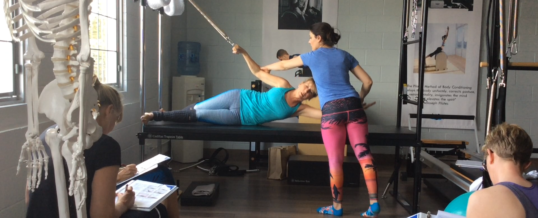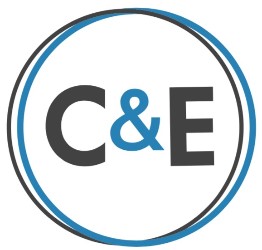
We’re done! (well, sort of)
On the Friday night of the final training weekend, Tanis tosses the teacher-trainees (TTs) into the pool – but only metaphorically. Several unfamiliar bodies show up for impromptu one-on-one lessons and the trainees must assess, program and teach –without consulting their manuals! Showing nerves only for a minute, each performs naturally and efficiently, spotting and adapting to compensation patterns and issues, while executing good flow and variety in their lessons. Tanis, Amy, and Corinne watch how the TTs communicate (are they too quiet or do they over-explain? With verbal and tactile cues?), how observant they seem of client movement, if they adjust to weaknesses, and also provide challenges.
The later debriefing is a review of common themes facing teachers: obsession over an individual body part; the need to constantly scan for footwork, anchoring, and organization of limbs; transitioning and challenging each body while keeping cues minimal and simple; and trusting both the system and the body. TTs laugh at how they get a workout while teaching because they mimic the efforts they request from students – as if it will help!
With the teaching so well demonstrated, all that is left for Tanis now (she claims) is to tie up some loose ends. TTs can still benefit from observing lessons of the more experienced, but all the teachers agree there is no substitute for teaching practice. After nine months of preparation, this we are now closer to believing, because the practice teaching has been providing increasingly specific questions for our master teacher. As one almost-apprentice teacher puts it, “paying customers notches up the responsibility.”
Thus the rest of the weekend evolves into a combination of useful reinforcement and scaffolding upon previous content. Tactile cues are emphasized and some new-to-us techniques like (gentle) joint mobility glides are demonstrated and practised — since it’s still a rather new feeling for some to handle other people’s limbs. (Also important to know one’s client, and his/her comfort level with this.)
“Simple in theory, hard in practice” becomes our mantra as we return to the mat repertoire, so fundamental, and more valuable at this stage of our journey. To better equip us, Tanis has customized a companion booklet to Joseph Pilates’ classic Return to Life. We can spend more time on the mat now because most of our bodies are ready to safely tackle more of the repertoire there, with or without props. The importance of teaching mat exercises is multi-fold, Tanis tells us. Not only to assess vulnerabilities and asymmetries (like hip gripping); but also to further challenge alignment, core, strength (as we try legs up in air without support); and ultimately so clients can do exercises on their own. Some populations apparently need mat more than apparatus to feel where the work needs to be. Several TTs share what seemed lacking in classes they had tried at other studios. Among other things, I learn the proper way to safely and effectively roll my tricky neck, twist my spine, and do side kick work. I also have fun rocking … it’s been a long while! After so much mat work, however, we all need Tanis to guide us through unloading the next morning, which doubled as a lesson about the various options for releasing the body’s patterns of holding tension.
Then off the mat we roll to the Reformer to tackle advanced exercises requiring ever more coordination and ever deeper work. The Long Stretch may look like a plank but it’s much harder to do correctly, being the flip side of the roll up. “The beauty of apparatus is that it makes the difficult safer.” Tanis adds that it is not necessary for everyone to do every exercise since many are similar in concept; readiness for each will vary. A progression of knee stretch and elephant, the long stretch needs flexibility and strength in the spine that not all bodies like mine have yet. (This morphs into yet more comparison of classical vs contemporary pilates…)
Interspersed throughout our weekend are discussions of common conditions, injuries, and inflexibilities (eg. osteoarthritis, disc problems, hip and knee and SI joints, even vertigo) coming into the studio and how to recognize and deal with them. For instance, the Cadillac is generally best for rehab because the teacher can play with ratios, resistance and repetitions. Rehabbers still need the same exercises but they can be modified to better concentrate on connection. One technique we try out is replacing feet with thighs in the leg straps. “Rehab clients will make you think hard about apparatus and use it wisely,” we hear (and nod knowingly now).
In our supervised teaching practice later, we absorb more teaching wisdom:
“Stay in moment, try not to think ahead or you will miss cues from the body of what is needed next.”
“Lesson plans generally need to be loose and flexible but based on the key elements. Always chart after.”
Tanis then surprises us by gushing about the progress she’s seen from this group of TTs who started the course with relatively modest Pilates experience, acknowledging how “difficult it is for a brain to accept a different way of moving one’s body.” Our commitment has been reflected in our own significant postural changes, she says.
But she also warned, this is just the beginning of true learning as Pilates professionals. Student bodies will continue to teach us for the next period of apprenticeship and mentorship, and our mastery should take a significant jump in level in six months. (Test time?) Corinne added another gem from neuroscience: “group involvement lights up the brain,” thus we owe it to ourselves to continue nurturing the network that we have joined in this year of intense Pilates.
Onward ensemble tribe!
